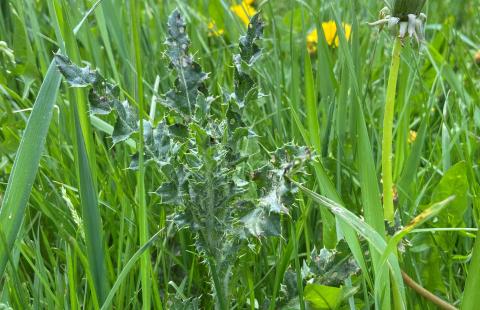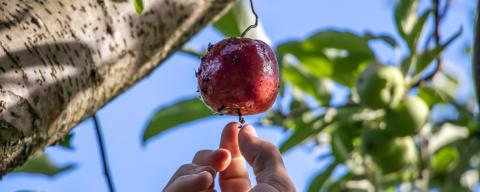Grasslands, including pastures and hayfields, constitute a relatively small but important part of the landscape in New Hampshire and New England. There are currently tens of thousands of acres devoted to forage production or pasture in New Hampshire. In addition to producing feed that supports the state’s dairy, livestock, and equine industries, grasslands provide habitat for wildlife and pollinators, cycle nutrients in soils, and prevent erosion. Grasslands and pastures also contribute to the character of the New England landscape.
Why Manage Weeds in Pastures
Pest management is a necessary consideration for any crop, and forages are no exception. We are fortunate in the Northeast to have few insects or diseases that cause serious damage to forage grasses and legumes, but weeds remain a challenge to growers. Grasslands and pastures are not a “stable” ecosystem in this region, and without careful management the plant population will shift towards a host of other species. Disturbances, large or small, create opportunities for new plants to colonize; pastures will first become more diverse with new broadleaf and grass species, and eventually will become populated with larger, woody species until eventually the open area reverts to a forest. Weed and pasture management is in part about balancing the resources and effort needed to maintain that grassland in a particular successional state.
For a species to be considered a weed it simply needs to be undesirable in a plant community. In natural settings weeds will likely have many beneficial characteristics, such as providing floral resources or soil stabilization following disturbances. In pastures and hayfields, weeds reduce the health, productivity, or quality of our crops. By competing for resources — water, nutrients, sunlight — the growth of weeds comes at the expense of forage production. Some weeds contain unpalatable or toxic compounds that affect animal performance by reducing forage intake, having lower nutritional value, or sometimes causing serious health problems. The species most likely to infest hayfields and pastures often share some characteristics: they are adept at colonizing newly disturbed areas, they can grow when nutrients or moisture are limited, they tolerate shade, and they often can withstand disturbance such as mowing.
Balancing Conservation and Production Goals
While pastures and native grasslands both provide important ecosystem services, there can be important trade-offs within the types of services provided. Managing pastures to optimize forage yield and quality by promoting soil health, selecting vigorous pasture species, and harvesting in a timely manner will decrease (though not eliminate) the diversity of non-forage species and suitable bird nesting habitat of that land, for example. These fields will also be more resistant to weed invasion. Conversely, optimizing wildlife habitat through reduced harvest frequency and increased plant species diversity will diminish the feeding value of the harvested forage.
It may appear at first that the goals of a landowner who favors wildlife conservation and those of a farmer who values forage production are incompatible, but compromises that balance forage production and wildlife conservation are possible. Mowing early in the season to preserve feed quality is still possible if there’s a 65-day rest period between cuts that allow birds to re-nest. Land that’s likely to be unproductive even with improved management — wet or rocky areas, for example — can be set aside as bird refuge areas. Growers can use flushing bars on mowers to prevent birds and other wildlife from getting injured by field equipment. Even changing the mowing pattern to start in the middle and work outward gives birds a chance to escape to refuge areas. Frequent and effective communication between landowners and farmers, along with a willingness to be flexible, will help both parties to arrive at a solution that’s mutually beneficial.
Integrated Pest Management: Basic Concepts
Integrated pest management (IPM) is best understood as a multifaceted approach to weed control. No single method of weed control is effective all the time for all species, or under all conditions. An over-reliance on single method can lead to new weed pressures, herbicide resistance, or damaged forage stands. By contrast, IPM uses periodic monitoring to assess when the presence of weeds is a concern and employs a variety of management practices to minimize weeds and protect crops.
The steps involved in an integrated approach to managing weeds include:
• Identifying weed pressures
• Assessing the extent of the problem, and whether it’s worth treating
• Acting when necessary, using a variety of practices that support the crop
• Monitoring results and modifying your approach over time
An Integrated Approach to Managing Weeds
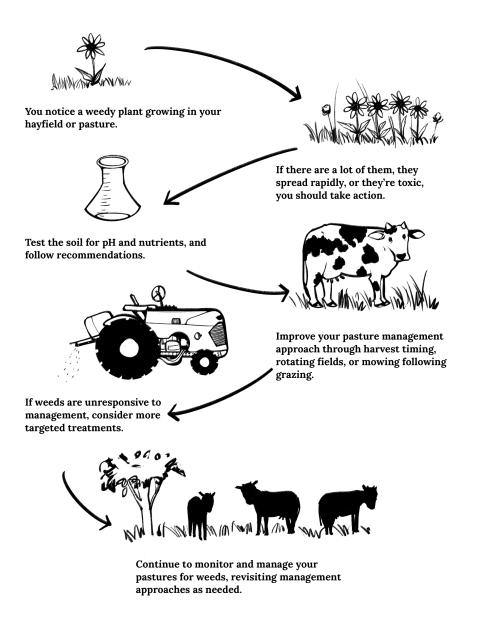
Identifying Weeds and Understanding Their Life Cycle
Weeds are a dynamic problem and predicting how they will affect forage quantity and overall quality can be difficult. An effective plan for managing weeds starts with both identifying which species are present and understanding their life cycles. Knowing when weeds are actively growing, or when and how they reproduce, informs decisions about the best methods to manage them. While each species is unique, there are several functional categories we can use to describe them.
As their name suggests, broadleaf plants are characterized by relatively wide leaves that feature a network of veins, while the leaves of grasses consist of long, narrow blades with a parallel arrangement of veins (there are several grass-like species, rushes and sedges for example, that can appear in pastures). While most grasses have a similar, upright growth habit, broadleaves may be upright or prostrate, with stems growing close to the ground and parallel to the soil surface.
Grass and broadleaf plants can both be further defined by how they propagate. Annuals complete their life cycle in one year, either germinating in spring and flowering and setting seed by the end of the season (summer annuals) or germinating in fall and going dormant over the winter before resuming growth, flowering, and setting seed in early spring (winter annuals). Biennials complete their life cycle in two years, growing vegetatively in the first year, then flowering and producing seed the second. Perennials’ life cycle lasts more than two years.
Depending on how they reproduce, some plants have more potential than others to spread throughout pastures and hayfields. Any species that reproduces solely from seed — annuals, biennials, and simple perennials — are less likely to result in serious weed infestations in healthy stands because developing seedlings have difficulty competing with well-established grasses and legumes. However, new seedings of forages are more vulnerable to infestations; unlike mature stands, there is often abundant light, water, and nutrients available to both forage and weed seedlings. Because many weed species grow quickly, they can crowd out slower growing forage seedlings.
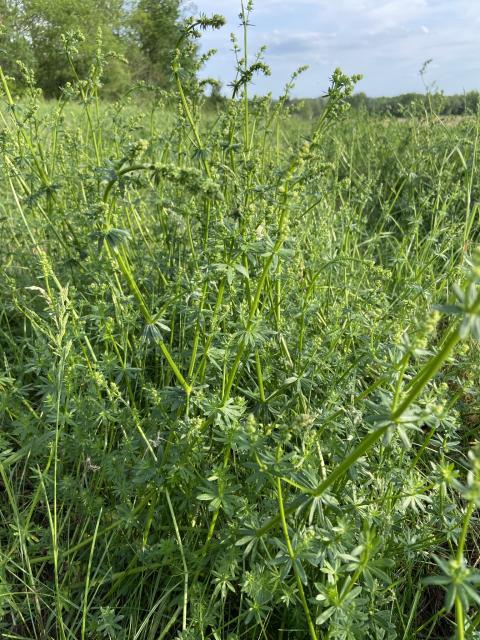
Smooth bedstraw (Gallium mollugo L.) produces high volumes of seed (light green, seen throughout photo), but also spreads by a creeping root system.
Certain perennials can also reproduce vegetatively, with new shoots emerging from creeping stems (stolons), root systems (rhizomes), or tubers on mature plants. These species can be more difficult to manage because new developing shoots are supported by the mother plant, making them more competitive overall and better able to increase their populations in established pastures. This growth strategy also protects them from certain weed management strategies that attempt to limit seed development such as mowing or clipping. Tillage, which otherwise disrupts and kills developing weed seedlings, can propagate new weeds when root fragments are spread throughout the field and develop into new plants.
Plant Traits to Help With Weed Identification
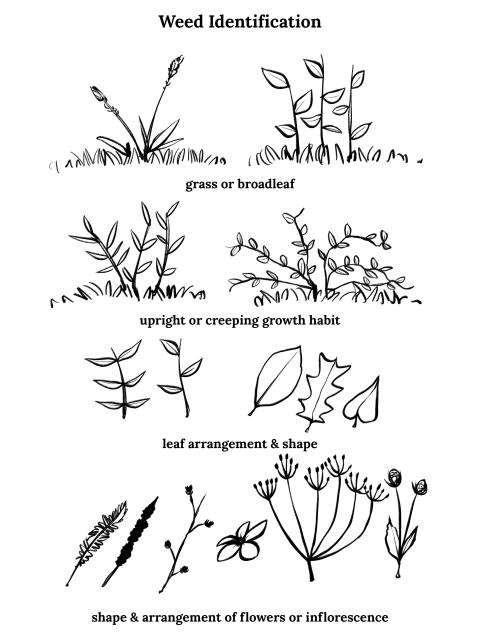
These general observations, along with some additional details, may help you identify the weed. There are several online resources, apps, and weed guides available.
• Note where and when you see the plant.
• Is it a grass-like or broadleaf species?
• What is the growth habit? Upright, bunching, or close to the ground?
• What type of root system does it have? Does new growth appear connected to other individuals?
• What is the shape and arrangement of the leaves? Are they opposite of each other on the stem or alternating?
• Is there a flower? Note the color and number of petals.
Taking a photo can be helpful. For best results:
• Capture the whole plant, filling the frame.
• Include a closeup of a mature leaf against a neutral background.
• Take a picture of a flower
Both Cornell University and the University of Wisconsin have websites with tools to help with weed identification:
Cornell University: http://turfweeds.cals.cornell.edu/
University of Wisconsin: https://weedid.wisc.edu/weedid.php
Establishing a Threshold for Action
The number of non-forage species in a pasture is likely to increase over time. This is not in itself a cause for concern; between the visible plants and a seed bank in the soil that has the potential to germinate in the future, most pastures and hayfields are not monocultures. The potential exists for populations of a wide variety of other species — miscellaneous broadleaf species like dandelion, non-forage grasses, and others – to harmlessly grow alongside forage grasses and legumes. It is only when those species are present in great enough numbers to affect the yield or quality, or if they are highly toxic, that they become a serious concern.
An Economic Injury Threshold is a way of evaluating the current or future risk of weed damage against the cost of taking action. The threshold is a subjective bar established by each grower or landowner, determined by both population size, and the potential for injury from the weeds present. Dense weed populations, rapidly spreading species, and toxic or unpalatable weeds generally have a lower threshold for action to limit their damage cost-effectively. On the other hand, sparse populations of weed species that are palatable and do not compete aggressively with desired forage grasses and legumes have a higher Economic Injury Threshold.
As an example of how different weed species may affect a threshold, Canada thistle spreads via both seeds and creeping rhizomes; a small patch can grow much larger within just a few years, and its vigorous growth is only checked by aggressive mowing combined with herbicides (the leaves and stems of thistles are covered with sharp spines, which discourages grazing). Dandelions, on the other hand, are much less obtrusive. They reproduce solely from seed and spread much more slowly than Canada thistle. Grazing animals consume dandelions along with forages with no adverse effects to their health —they’re not toxic, and their nutritional value is actually similar to that of grasses and clovers. It’s only because the dry matter yield of dandelions is low, and a pasture dominated by them would support far fewer animals than a vigorous stand of grasses and clover, that they’re a concern at all. Control measures could eventually be justifiable, but only at high densities. Because an infestation of Canada thistle is a more serious threat to pasture production than dandelions, it has a lower threshold for implementing control measures.
The Relationship Between Soil Seed Banks and Above-Ground Weeds
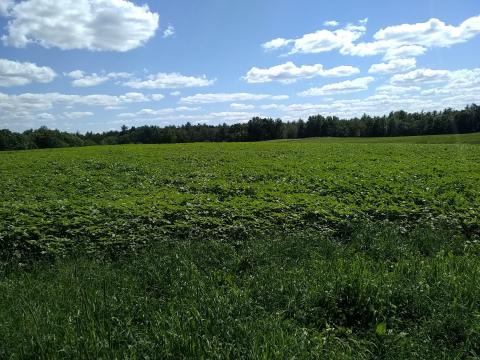
A near monoculture of Redroot pigweed (Amaranthus retroflexus, background) emerging after a spring tillage event in a pasture. Pigweed seeds had lain dormant in the weed seed bank for at least 10 years
without posing any issues for the pasture, likely deposited into the soil during the last rotation of annual crops through the plot.
In a study on weeds in pastures, researchers measured all the “above-ground” weed species present, and took soil samples from several hayfields and pastures on a dairy farm in southeastern NH. The soil samples were taken to a greenhouse and the “germinable” weed seeds were grown, counted, and identified. Weed communities were strongly influenced by field management history and the timing of sampling. Seeds in the soil (those that could potentially germinate if given the opportunity) ranged from 1,560 to more than 20,000 individuals in a square meter. A total of 66 different species were found in the weed seedbank, although the total number of seeds found at any single point in the field was variable, ranging from 0 to 80 at the extremes. In a healthy stand of forages, the weed seedbank does not necessarily represent the weeds that are “expressed” but can indicate future potential issues at the site should there be disturbance from overgrazing, trampling, or tillage. Knowing the characteristics of the seedbank, such as whether summer or winter annuals are dominant, could be very helpful in planning a disturbance event such as tillage.
Sanderson et al. (2014)
Canadian Journal of Plant Science 94(4)
Using a Variety of Management Practices
After identifying weed pressures and assessing the extent of injury they’re causing, an integrated approach to managing weeds will use a combination of biological, mechanical, cultural, and chemical methods to reduce the population to where they no longer cause serious crop injury.
Mechanical control practices usually involve mowing, tilling, or hand removal (roguing). Tilling has limited use in perennial hayfields and pastures, and hand removal is impractical for all but small infestations of relatively large species like bull thistle. Mowing, however, can be quite effective by capitalizing on important differences between weeds and forage species.
Certain grasses and legumes have become favored forage species because they’re adapted to tolerate repeated defoliation by mowing or grazing; growing points are located where they are unlikely to be removed by grazing or mowing, or their root systems store enough carbohydrates to allow them to grow back without exhausting energy reserves and weakening the plant. Many weeds do not have these adaptations and cannot withstand mowing or more intense grazing pressure. Repeated cutting, therefore, whether specifically targeting weeds or from timely harvesting or grazing of forage, weakens broadleaf weeds and makes them less able to compete with more vigorous grasses. The technique can be very effective against annuals and upright perennials, but it’s less effective against weedy grasses or species with low or prostrate growth habits because they retain enough leaf area at normal mowing or grazing heights that it doesn’t deter weed growth.
Fundamentally, if forage stands are healthy, there are fewer spaces for weeds to germinate and they are less likely to thrive if they do. Cultural methods refer to any measure that either enhances the competitive ability of crops or reduces that of weeds. Many of these practices — tillage, crop rotation, building soil fertility — are done before a crop is planted, and they will provide benefits that extend for the life of the crop. While annual weeds can replenish their populations from the seedbank, forages rely on the survival of the planted individual, making weed management in young stands especially important.
While many hayfields and pastures are best suited to remain as grassland indefinitely, periodically rotating to annual row crops helps to reduce perennial weeds that cannot be managed by cutting. Maintaining soil fertility by liming and regular applications of manure or other amendments according to soil test recommendations ensures that nutrients are available to support strong forage growth that outcompetes weed seedlings over time. Selecting forage species that are bred or well adapted for their intended uses and environment also increases the chances of having a vigorous, competitive stand. Including multiple species in mixture can also help utilize available resources, decreasing their availability to weeds, and often leads to more productive and higher quality forages, especially when grasses and legumes are combined.
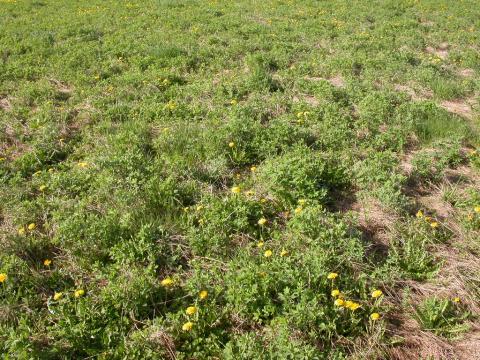
Plant vigor in this alfalfa stand is low, creating niches where dandelion and other weeds can germinate.
Harvesting or grazing practices influence the health of forage stands and the subsequent risk of weed encroachment, but they are also an important tool in managing the health and persistence of weeds. While grasses withstand repeated defoliation better than many weeds, cutting or grazing too closely to the ground or too frequently does eventually weaken them. Allowing grasses and legumes a recovery interval between grazing or mechanical harvesting keeps them healthier and more competitive with weeds. For pastures, rotational grazing gives better results than continuous grazing, where frequent and repeated defoliation without recovery periods results in weakened grass and creates opportunities for weeds to establish. In hayfields, plan on an interval of at least 30 days between cuttings and avoid leaving a stubble of less than four inches. Ideally, harvests in the fall are timed to either allow forages to recover before a hard frost, or occur afterwards, when the stress to the plants is minimized.
Healthy forages will resist most weed encroachment, but it’s still important to avoid introducing potential problems. Basic sanitation limits the introduction of weed seeds that could develop into future infestations. Clean debris from mowers and other equipment before leaving a field, and avoid bringing in feed from outside sources known to be contaminated with problem weeds. Use only certified seed for any new seedings or renovations — quality seed sources maintain high standards for the percentage of viable seed, and screen for the presence of noxious weeds. Overseed forages into any bare areas that emerge after trampling or resulting from aggressive weed management.
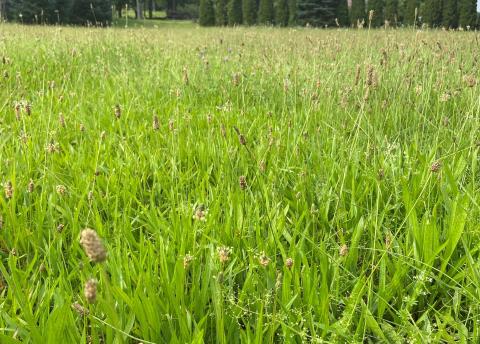
Herbicides may be the only option for low growing perennials that aren’t affected by mowing, such as buckhorn plantain (Plantago lanceolata L).
Chemical herbicides can be an important tool in managing weeds, and they may be the best option for persistent species that don’t respond to non-chemical control methods.
However, they also have their limitations. Herbicide use is not a substitute for good forage management; using them without addressing deficiencies in soil fertility or grazing or harvesting management will likely provide only short-term benefits at best, because nothing has been done to change the conditions that allow weeds to thrive or improve the vigor of forages. Over time, heavy reliance solely on herbicides can even lead to weeds developing resistance.
Herbicides such as glyphosate (the active ingredient in Roundup products, along with many others) are considered broad spectrum materials because they’re active on a wide range of plant species. These products have limited use in hayfields and pastures because they also kill the perennial grasses and legumes we want to protect. Still, these products may be useful for spot applications where heavy weed infestations are confined to discrete sections of a field, or for burndown treatments that eliminate all vegetation in preparation for reseeding.
Selective herbicides are only active on certain types of weeds, and those that are active on broadleaves (e.g. Dicamba, triclopyr, and 2,4-D). They may be more useful for managing weeds because they leave the forage stand mostly intact (they may kill off or at least suppress clovers and other legumes). However, these products vary in how they kill target species, and not all products are equally effective against all weed species. Several Land Grant Universities in the Northeast region publish herbicide recommendations that can provide further guidance.
Monitoring Results
It’s necessary to evaluate how effective the management practices you employ have been so that you can either stick with a successful combination or modify your approach to get better results. You don’t need an elaborate record-keeping system, but taking notes each year on changes in weed populations, pasture condition, forage yields can help to identify what approaches will have the best chance of success.
Conclusion
Grasslands, pastures, and hayfields are important pieces of the northeastern landscape - both for the habitat they provide and the agriculture that they support - and integrated weed management is a key intervention in keeping them productive. Use cultural practices that favor forages and discourage weeds from infesting fields in the first place. Monitor fields for problem weed species, and when found, manage them using a variety of mechanical and chemical approaches as needed. Continue to scout fields for weedy species, to address changes in soil health, and overseed forages.
*This publication was funded by a Partnership Grant from the Northeast IPM Center.
Photo/Illustration Credits
1. An Integrated Approach to Managing Weeds & Plant Traits to Help With Weed Identification Illustrations by Sydney Smith
2. Pigweed photo by Nicholas Warren
3. All other photos by Carl Majewski
Contacts
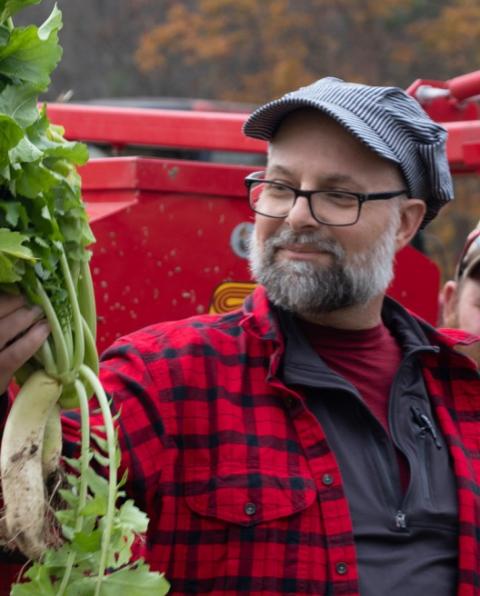
Carl Majewski
Extension Field Specialist
carl.majewski@unh.edu
Phone: (603) 352-4550

Nicholas Warren
Research Scientist I
Natural Resources and the Environment
nicholas.warren@unh.edu
Phone: (603) 862-5304
Extension Services & Tools That Help NH Farmers Grow
Newsletters: Choose from our many newsletters for production agriculture
Receive Pest Text Alerts - Text UNHIPM to (866) 645-7010
